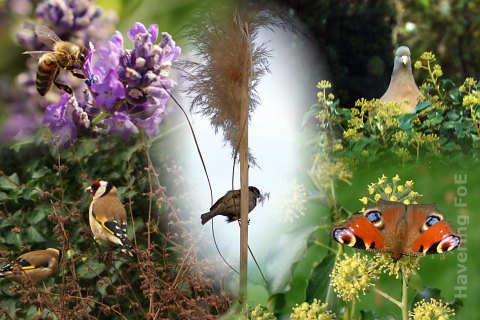Re-wild your garden
by John Robinson; first published 1-Apr-2022

Wildlife in a garden - John Robinson
Re-wilding is in fashion, and what better place to start than in your own garden. But it needn't mean buying "wildflower seeds" or tree saplings. If you're not in a hurry for results, just sit back as I did, and let nature take over - with just a little intervention now and then to avoid a jungle. All sorts of self-sown wild plants have appeared, and some migrate to different parts of the garden from year to year, as if they're doing their own crop rotation. Forget-me-not is an example - it wanders around, but every few years, true to its name, it flourishes again in the patch where it started.
Havering Friends of the Earth campaigns against the use of chemicals such as glyphosate and neonicotinoids, which endanger many living things in addition to those they're supposed to "treat". It's always best to work with nature instead of fighting it - leave things alone, and equilibrium will usually be restored. Some shrubs in my garden used to be attacked by swarms of aphids, and like an idiot I tried to "control" them with chemicals. One year I didn't spray; a colony of small insect-eating birds established itself, and presto - no more aphid problems.
One plant that does need constraint is ivy; left unchecked its sheer weight can bring down a small tree. Trim it back soon after new growth starts, so it can flower and attract butterflies in autumn. The berries, too, are appreciated by blackbirds and pigeons in the winter. Two useful herbs have appeared in my garden - Garlic Mustard and Lemon Balm. I let the latter set seed last year, and a flock (aptly known as a charm) of goldfinches turned up one day, and enjoyed a real feast! Far better for them to forage in the natural way, rather than being fed "human food" such as bread.
I used to list gardening as a hobby, but now I call it "garden management". You might very well think that, like some other management jobs, that's just another term for "an easy life". I couldn't possibly comment!
![[Earth icon]](../emblem64.jpg)